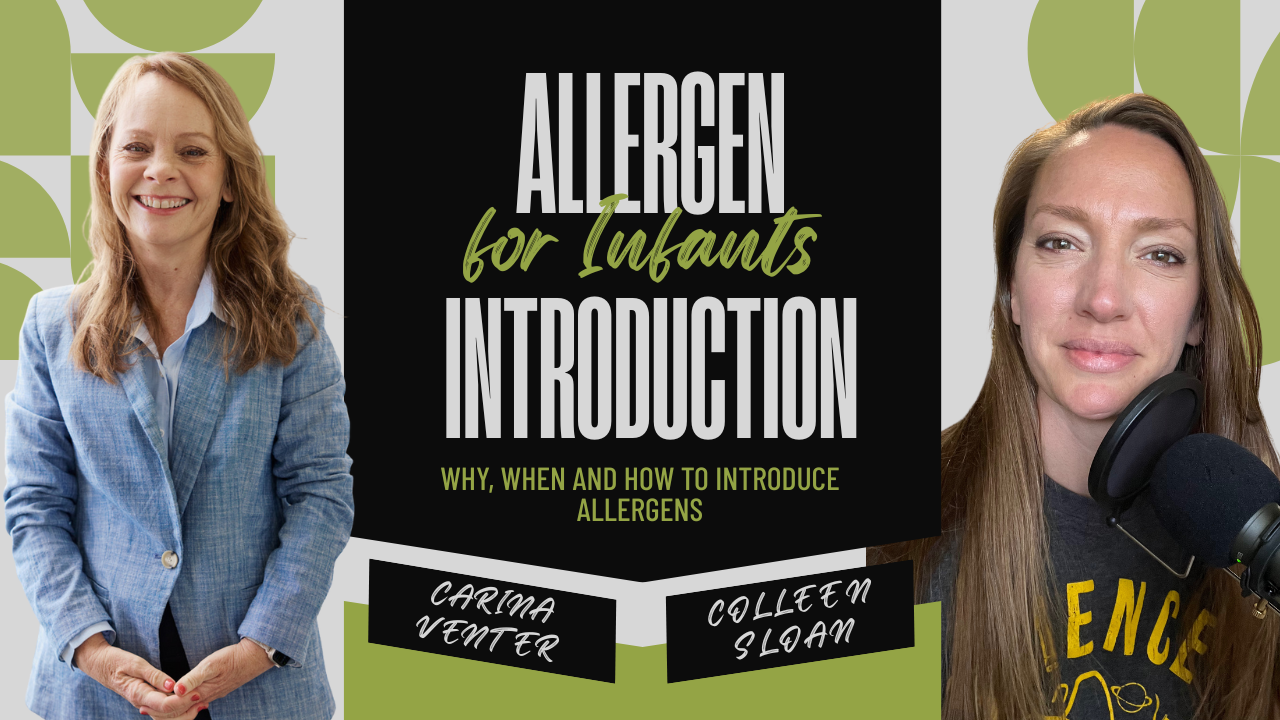Introducing Allergens: A Step-by-Step Guide to Early Allergen Introduction in Infants

Immediately after I just told a new mom it was time to introduce peanut to her baby, she fearfully looked up and said, “Are you serious… now? He’s only five months.”
You’ve probably had that same moment in clinic. The nervous laugh. The tight shoulders. The fear written all over their face.
Honestly, her reaction makes total sense. For years, parents were told to wait. Now we’re asking them to do the exact opposite. No wonder it feels confusing. And scary.
That’s why I sat down with Dr. Carina Venter—one of the world’s leading experts on food allergy prevention—for Episode 126 of the Exam Room Nutrition Podcast. She’s spent decades studying maternal diet, infant feeding, and allergen introduction, and she gave me the clearest, most practical answers to the exact questions you and I get every day in practice.
And because I know you don’t have time to memorize it all, I typed up my notes into a simple PDF you can grab here. Something you can glance at in the office, or pull up on your phone before a well-visit.
Key Takeaways
- Start the allergen talk when you discuss solids. Earlier is safer than waiting—the infant immune system is friendlier in the first months.
- Order that works in the U.S.: peanut → egg → milk (often happens via yogurt) → cashew → walnut/pecan → sesame; add fish/shellfish/soy with family foods.
- How much counts as “exposure”? ~2 g protein of the allergen twice weekly (e.g., ~1 tsp nut butter, ⅓ cooked egg, ¼–⅓ cup yogurt).
- Keep it consistent. Ongoing intake ~2x/week for years (aim through ~age 5) supports tolerance.
- Safety pearls: Thin nut butters in yogurt/breast milk/formula to avoid choking; “egg ladder” = start with fully cooked (hard-boiled/firm scramble) before softer forms.
Answers to Common Questions
1) Can maternal diet during pregnancy/breastfeeding reduce allergy risk? Yes—think diet pattern over single foods. More vegetables and fermented foods (e.g., yogurt/kimchi) with less low-fiber, sugary, fried foods and less meat is associated with lower risk of food allergy/eczema/asthma in children. No need to avoid allergens if tolerated; if she likes peanut, she can keep eating it.
2) When should babies start allergens—and in what order? Begin as soon as solids start (after 1–2 fruit/veg trials). In the U.S., prioritize peanut and egg (highest prevalence), then milk (often via yogurt), cashew, walnut/pecan, sesame; integrate others with family meals. Early exposure is safer than waiting; anaphylaxis in young infants is very rare.
3) How many days between new allergens? No hard rule. Practical approach: one new allergen every 1-2 days. Immediate reactions declare themselves within minutes to 2 hours. Use shared decision-making—nervous families may prefer one new allergen weekly; confident families may move faster.
4) What amount and how often to maintain tolerance? Aim for ~2 g protein twice weekly per allergen (e.g., ~1 tsp nut butter, ⅓ egg, ¼–⅓ cup milk). Keep exposures ongoing (about 2x/week); consistency matters more than perfection.
5) Egg specifics: yolk, white, or whole? Use whole egg (major allergens are in the white). Start with well-cooked options (hard-boiled mashed; firm scramble 6–7 minutes), then progress to softer preparations—an “egg ladder” approach. Expect occasional mild hives; severe reactions are uncommon in young infants.
Why This Matters (beyond allergy)
Each allergen exposure may also support a healthier gut microbiome; diverse diets and fermented foods are part of a broader immuno-nutrition lens your families can adopt.
Listen to the Episode
Want the full conversation (plus quick ladders for milk and egg, and how to counsel the anxious parent)?
Tune in now to my conversation with Dr. Carina Venter—it’s packed with evidence and scripts you can borrow verbatim for your next well-visit. Click here to listen!






